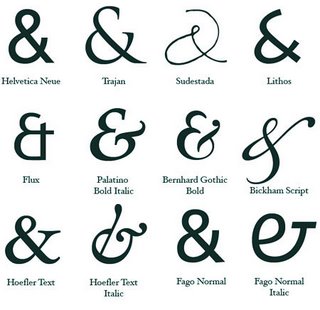This morning, I bring you the question of the ampersand, dear readers. I’ve just spent a solid chunk of time with the entire manuscript, reading from start to finish, but darting to the computer to make minor tweaks for consistency throughout. One involved the phrase “the woman I called mother by mistake.” Sometimes I’d italicized and sometimes not. I went with the italics.
The other inconsistency I noticed was my use of the ampersand.
From Wikimedia Commons: An ampersand (&) is a logogram representing the word “and.” The symbol is a ligature of the letters et, which is Latin for “and.”
From this definition I’m startled by the words “logogram” and “ligature.” Logogram simply because I’d forgotten it and think it’s a cool word; ligature b/c I watch too much Law & Order and associate it almost entirely with a method of killing (i.e. strangulation), but when looking it up again, I notice that it applies to typography and to music as well. The music definition I once knew and had forgotten, the typography definition seems new to me.
 |
| from Creative Commons, click for link |
So, apparently, there are people in the poetry world who have strong feelings about the ampersand. My most vivid memory is from an interview I found once online that included Jeanne Leiby (may she rest in peace), who at the time of the interview had just become the editor of The Southern Review. What I remember is how adamantly she spoke against the ampersand, claiming that poets used it frivolously and should just type out the word “and” b/c it wasn’t saving any syllables so it must be a purely visual thing and she thought that detracted from the poem itself. One brave student in the audience (it was an interview at some grad program) offered that she used the ampersand in homage to Larry Levis, but I can’t remember Leiby’s response to that.
I confess, I love the ampersand. I love the symbol and the word. I love how it looks on the page and I do believe that I read it slightly differently than I read the word “and” but I’d be hard pressed to prove that.
As I was reading the manuscript-in-progress this morning, I saw that I had sometimes used the ampersand and sometimes not, so I really started looking at the why and how of it. It seems to me that the ampersand works very well when grouping two nouns or verbs in a way that they become nearly one word and their distinct definitions blur together a bit in the mind. I also think it works to speed the pace of the poem, but again, I can’t prove that.
I do remember that when I was putting together a group of 10 of the early poems to submit to some fellowship application or whatnot, I took all the ampersands out b/c I was afraid whichever reader got my application might be one of those ampersand detractors.
What do you think? Do you think an editor or reader for a fellowship/grant would dismiss a group of poems for the use of this symbol or do you think I’m over-thinking this? Does the ampersand bug you or feel right at home in the poem?


I am sometimes enamored of the ampersand, sometimes irritated by it. When I use them, I invent all sorts of reasons: they are visually pleasing. They are interesting. They (maybe) speed the reading. I think they manage both to call attention to themselves and to be less obtrusive than the word they replace. Sometimes I use them because I used the word "and" too much, and using an ampersand reminds me to cut back.
Coincidentally, I had a poem in Jeanne's last issue of The Southern Review, and it used ampersands. The editors (not Jeanne herself) asked me if they could change them; I actually cited Levis when I said I'd prefer to keep them — and they
let me keep them.
As for your question, I think it is indeed possible that some editor would decline based solely on the use of ampersand. Impossible to know, though.
Thanks for this thoughtful response. Glad to know I'm not alone. 🙂
I love the ampersand, too, but I find myself using it in poetry only in certain cases–when the speaker is thinking quickly, might be abbreviating, etc. Or in other very specific cases.
I loved all your pictures of the ampersand and the explanation.
I do think some people might be sticky on the topic, re: grants, but I haven't run into any objections from publications.
Kathleen, thanks. I definitely think there is an element of speed there, and I think that can be a sound justification.
I do not like the ampersand, but that is the editor in me talking. I have used it in a few poems, but really I try to stay away from it. Mainly because I see it used inconsistenly in poetry collections.
Lucille Clifton used the amersand often, and I wonder if she liked the look or if it really meant something in the poems.
(Thanks for the L&O reference. That's how I think of ligature when I hear the word.)
January, thanks for the contribution to the discussion. I <3 Lucille Clifton & her work in the biggest way, so perhaps some of that is seeping through.
BTW: Notice the ampersand in Law & Order. 🙂